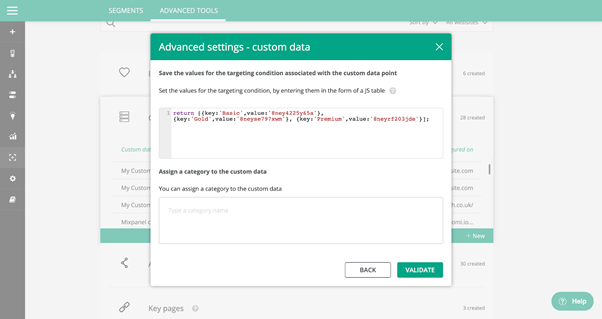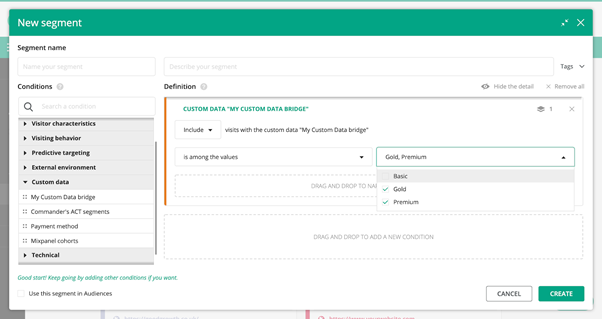
Faster integration across your experimentation stack with the Kameleoon Custom Data Value Bridge
In a world full of data, you need your testing platform to integrate with tools across the martech stack. The better you can integrate the tools you use, the higher your experimentation program can perform.
We covered some of the must-have integrations your program needs to have in 2021, based on talking to industry experts. However, once you get to a certain maturity level, native or non-custom integrations won’t give you the clearest data and analytics you need for YOUR particular business requirements.
To solve the problem, you need an experimentation platform that allows you to move beyond pre-built integrations and create your own custom integrations in an easy, flexible and fast way. Any platform that can’t do this causes your program to slip in performance, harming your business.
As Silver Ringvee, CTO for Speero, a customer experience optimization agency, , explains, “As an advanced user,I would pick a testing tool with a decent open API first any day, compared to tools with some shiny plug and play solutions but no API.”
That’s why we’ve introduced the Kameleoon Custom Data Value Bridge, to give developers, product managers, and marketers the power to create their own custom integrations - in less than one day - with the tools they know drive their business forward.
The aim with the Custom Data Value Bridge is to provide the best of both worlds:
- Easy tooling to integrate with a third-party tool (for developers)
- Simple to use interface to build segments from it (for marketers)
1 What is the Kameleoon Custom Data Value Bridge?
The Kameleoon Custom Data Value Bridge makes it simple to build your own custom integrations between our experimentation platform and the rest of your martech stack.
Need to connect to a specific DMP that is strong in your industry or only bring in certain data from a CDP to fuel your experiments?
The Custom Data Value Bridge enables you to quickly create these integrations, based on your specific needs and requirements.
A Swiss Army knife for your integrations
Pre-built integrations work well in certain circumstances, but as your experimentation program accelerates, you are likely to want more flexibility than they offer.
“We see the Custom Data Value Bridge as a Swiss Army knife that lets you connect to any other tool (such as a DMP, CDP or others), get the data (usually segments ID and Labels), and make it readable for the end-user in our segment builder interface, “ adds Ulf Mayer, Kameleoon. “It automates the process in a secure, straightforward way - the possibilities are limitless!”
Create meaningful connections for your experimentation
The key point of our Custom Data Value Bridge is to make your customer data as helpful as possible.
Most experimentation platforms can import data from an external tool using their in-built APIs. But it takes time to implement the bridge and tailor the data so that it is in a format that is secure, understandable and usable for key stakeholders.
Often, data is labelled with internal IDs that are just a string of numbers and letters, rather than something obvious (such as VIP customers). Using your organization’s language and categorization is key to driving adoption by marketers and executives at your company. With the Custom Data Value Bridge you can rename incoming values so they match your naming criteria. Data is kept secure as segment names are only available to the end-user, and aren’t accessible client-side or made visible in the browser. Data is thus much more usable to marketers while ensuring security and compliance.
Create a bridge in one day
For developers, they can use our API to create a bridge in under a day, making the data available seamlessly to aid experimentation. This ease of use is all part of our focus on helping developers get the most from experimentation and our platform, as our new integration with Git and the ability to write experimentation code in Microsoft Visual Studio demonstrate.
To enhance your targeting and segmentation for experiments, you can now bring custom data straight into Kameleoon. That allows you to focus your audience by creating specific custom data flows that automatically integrate with the platform.

When a developer builds a bridge, raw values (segment IDs) can be associated with a label (segment Name).......

The labels and values are obtained dynamically when the segment builder interface is displayed for this custom data. This allows you to present a select box when using this custom data in a targeting condition, rather than a plain text field. It's thus much easier for the end-user to select the value on which to target.
2 Use case - Building a Kameleoon Custom Bridge to Piano DMP
In 2020, we worked with major international media company Die Welt. It uses Kameleoon for A/B testing and personalization as well as the Piano DMP.
Piano is a cloud-based platform designed to create customized digital experiences and build commercial relationships with site visitors. Its Data Management Platform (DMP) allows brands to combine first-, second-, and third-party data with volunteered zero-party data. It helps make everything a brand knows about a user immediately available for segmentation and targeting.
The company wanted to create powerful user segments within Piano DMP and then use this data for targeted onsite journeys and customized experiences via Kameleoon. Without a direct integration between the two tools that met its specific, tailored needs this was proving complex and difficult to achieve. To overcome this and to connect the two, it used the Kameleoon Custom Data Value Bridge, with its developers creating the integration internally within a day.
This integration enables its marketers running experiments to:
- Read user segments and transfer this to Kameleoon
- Receive deeper data, such as cohort names and IDs
- It can then create individual segments in Kameleoon and use these to create custom personalizations based on the entire dataset
With no need to copy/paste ids from Piano to Kameleoon anymore, experimentation and personalization is faster, dramatically reducing the potential for errors to creep in. As marketers can see and understand the names of segments, rather than having to guess them from strings of numbers, the whole process is easier and more efficient.
3 What are the benefits of the Kameleoon Custom Data Value Bridge?
We first developed the Custom Data Value Bridge to help accelerate building integrations with third-party tools as part of our partner program. That means it has been proven across a range of integrations we’ve created with Mixpanel, Commanders Act CDP, Salesforce Audience Studio and Tealium. These custom integrations were successful because of the speed and openness that the Custom Data Value Bridge enables.
Faster integration
As a developer there’s a lot of pressures on your time - you need solutions that are simple to use and fast to implement. Developers running experimentation programs can create bridges in a day - meaning you can take control, without needing to involve Kameleoon support staff. Altogether this accelerates experimentation and thus drives greater business value. You can standardize the process to make it repeatable and high quality as you integrate a wider range of tools with your experimentation platform.
Depth of personalization/experimentation
As a marketer designing and creating experiments you can get a much more detailed view of visitors, and then use this to better target them with experiments and personalizations. Custom data can be used across all Kameleoon dashboards, from reporting to audiences, helping increase value from experimentation.
Maximize investment/enable innovation
Get best value for money from your entire martech stack by plugging all tools (and their data) into Kameleoon. This expands what data you can bring into experimentation and encourages innovation. You’re no longer held back by unintegrated tools.
Better UX for users
When creating, targeting and running experiments and personalizations you can clearly see the types of data being brought into Kameleoon, following your own naming conventions. Data types are accessed through drop down lists, making it a seamless part of the experimentation and personalization process. Users simply access a select box when using this custom data as a targeting condition, rather than a plain text field. That makes it much easier for the end-user to select the value on which to target.
Successful experimentation and personalization requires agility, speed and the ability to harness all of your data and tools. Kameleoon aims to put developers in control - and the Custom Data Value Bridge is part of that.
Find out how to build your own integrations with Kameleoon using the Custom Data Value Bridge by reading our technical documentation and contact our tech partnership manager to learn more.





